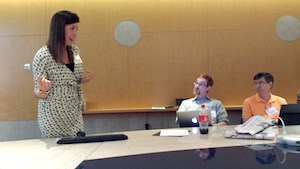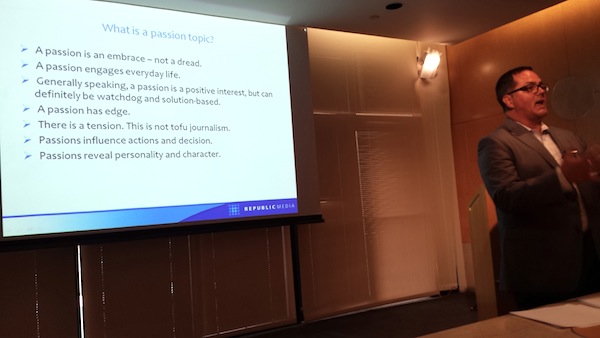News companies, especially newspapers, were historically organized to pursue mass audiences. The goal was to build up the biggest possible audience by covering the widest array of general interest topics.
That’s no more.
In a consumer-driven media age, in which charging for digital content is becoming a large part of the business model, publishers have to focus more on individual users’ needs and desires.
The new goal, then, for news companies is to inspire active engagement with focused groups of loyal users. Specialization is the only way to do this.
Strategies to determine your target audiences and develop plans to to serve them desirable content were key areas of discussion at the most recent American Press Institute workshop, held at The Arizona Republic. The event, “Growing Your Audiences, Growing Your Business” was the final stop on the Transformation Tour, a series of training sessions put on by API in concert with the Poynter Institute.
We shared insights from Brooke Christofferson, Republic Media vice president of market and business development; Randy Lovely, Republic Media senior vice president of news and audience development; Rachel Davis Mersey, associate professor at Northwestern University’s Medill School of Journalism; Kurt Caywood, vice president of audience for Times-Union Media; and Nathan Gwilliam, director of strategic verticals for Deseret Digital Media.
From their presentations and interactions with participants we identified 10 key insights:
1. A reader may give you only one or two chances to prove you are relevant
Mersey cited research that indicates readers used to give media companies six to seven shots before giving up on them as a source of information in their lives. That number now has dropped significantly to about 1.7, she said.
People have abundant sources of news, and such competition leaves less margin for error when it comes to earning customer loyalty.
2. Despite abundant sources, users can only retain so much information
There also are biological reasons not to cover general-interest news and try to be all things to all people. A human brain can only follow developments on two to three complex news issues at a time while juggling the other normal demands of life.
Mersey said people may change the two to three things they follow depending on life circumstances. But humans only have the capacity to retain limited chunks of information. This is an important realization for news editors and a reason to hone in on specific interests and passion topics.
The amount of information sources consumers must choose from can be overwhelming. The “paradox of choice” explains that people facing too many options can be paralyzed. When that happens, people rely on habits or tap into their social connections to simplify their options.
3. One size fits no one
General-interest approaches that attempt to appeal to everyone end up appealing to no one in particular, Mersey said.
At Republic Media, publisher of the Arizona Republic, Lovely said the goal is not to be a commodity news source. He sees original content produced by staff as a differentiator. In a digital world, there’s room for many different media companies so long as they’re providing different value.
“A lot of things can live if they’re focused on a niche in the marketplace,” Mersey said. “Think of yourself as six thoughtful, targeted products.”
4. Carve your marketplace into niches and target segments by time of day, platform and topical interest
Newspapers have long segmented their print products into sections. In a digital context, segmentation can be more sophisticated. It’s also more important to zero in on specific audiences and then match stories to them on the most appropriate platforms.
Mersey provided an example of a local TV station that struggled with its lunchtime Web traffic. Guided by TV viewership trends, station executives tended to see the noon news hour as a less valuable time block on the website.
But then they engaged in research to ascertain what viewers wanted midday: updates on the news stories reported throughout the morning, ideas for dinner (particularly a dish in which ingredients could be picked up on the way home) and a way to add levity to the day. As a result, the station created a new web product called Lunchbox. Its features were simple – four or five updates from morning news stories, a light story and a discount coupon for dinner that night. Lunchbox more than quadrupled traffic in the time slot and brought in new revenue.
The example illustrates the power of thinking about a marketplace in a new way and creating a product with a target squarely in mind.
5. Doing everything is not an option, so be memorable
Lovely refers to the temptation to churn out average, passable general-interest content as “the mediocre middle.” Republic Media’s goal is to banish this from its products.
“If what you’re doing today is forgettable tomorrow, you have to ask if that’s a good use of your time,” he said.
His newsroom seeks to strike the right balance between hard-hitting watchdog journalism and gripping human interest features that celebrate the characters of the community. In either direction, the key is focus and specialization.
In doing this, he says, journalists’ roles have changed. No longer is the desirable approach to be able to jump into any story or any topic. Gaining audience trust lies in being viewed as a subject matter expert.
Refocusing content and capitalizing on what the Florida Times-Union can do better than anyone else has been critical, audience VP Kurt Caywood says. The newspaper now has a two websites – a free one, and a paid site that features eight to 12 pieces of premium content that is both unique and compelling.
According to Caywood, the newspaper had to cut back on some types of coverage in order to better focus on premium content. For instance, there used to be a full-time music reporter. But because music is not a core subject for the marketplace or audience it was scaled back in favor of bolstering investigative work.
6. Everyone has a role in marketing content, not just the marketing department
Media organizations have often done a terrible job of telling the public what they do and the relevance of their work, Caywood says.
But there’s now a heightened emphasis on marketing content and explaining its value to readers. The speakers at the API workshop were in agreement that publishing articles won’t prompt users to read and share them without deliberate effort. And the responsibility doesn’t just fall on a dedicated marketing department, especially as news organizations have cut back on research and marketing staff.
“We need to get better at promoting ourselves,” Christofferson, of Republic Media, said. “Everyone has a role. It’s very much a strategy, not a tactic about driving people to different platforms.”
For example, the Arizona Republic takes specific steps to point out content to readers in a variety of ways. They’ve begun a “Best of the Best” feature that goes out to subscribers via email, on the homepage and in print. “Best of the Best” draws their attention to high-value stories and art the reader may not have seen. Similarly each month the Republic highlights coverage readers may have missed that past month, including great storytelling, exclusives and databases.
7. Own every platform
 The Arizona Republic staff is divided into teams. There are nine different content concentrations and six different platforms. That means the platform specialists are tasked with mastering the platform to which they are assigned, for example, understanding what works best on tablets.
The Arizona Republic staff is divided into teams. There are nine different content concentrations and six different platforms. That means the platform specialists are tasked with mastering the platform to which they are assigned, for example, understanding what works best on tablets.
“Even though people’s jobs are to be to ‘platform perfect’ it’s still important for them to understand what we want to accomplish with other platforms,” Lovely said.
The goal, therefore, is to create equally great experiences customized to each platform or device.
8. There’s huge value in using research to develop new products
The Arizona Republic is a major proponent of using research to understand its audience and create better news experiences.
Christofferson explained that her team looks at audiences in three dimensions – their life stage, the current conditions of their lives and the shared experiences they have gone through with peers. They then use primary and secondary research to come up with groupings of users, study their behaviors and preferences and create products around these qualities.
Each year, Christofferson said, the newspaper will conduct 50 research panels with users who have signed up to provide feedback and insights. She’ll also use data sources such as Scarborough to gain further understanding and set goals.
“If you understand users’ behaviors, where they live, it paints a full picture and brings them to life,” she said.
Caywood said his company also sees the value of studying users and market conditions. It’s simply too risky to build a business on spec anymore, he noted.
9. Don’t just build a social presence for your brand; build around specific topics that draw passionate communities
Deseret Digital Media reaches 500 million people monthly across all social media and publishing platforms. There’s no way a Utah newspaper could ever do that with just legacy platforms, Gwilliam says. The key was creating deep engagement around topics of passion and creating social media channels around these passions.
Gwilliam describes the old media model as “one glorious stream of content” pushed out to everyone in one fell swoop.
The new model is multifaceted and multi-dimensional. Step one is to identify passions of users, both existing and aspiring. Next, Gwilliam says, an organization should create vertical channels around these passion topics using the most suitable platform – YouTube channels, Pinterest, a website, email newsletter, Facebook page, etc.. Then, allow users to follow their passion topic through these channels and continually push out fresh content to them. Lastly, help users engage with you and each other around the topic.
Gwillam said he sees particularly unbelievable potential with YouTube and suggests media organziations look at companies like SoulPancake that are rolling out highly shareable video.
10. Search for the one key metric
In the famed book and movie “Moneyball,” baseball recruitment is boiled down to one key statistic – players’ ability to get on base. Gwilliam thinks in media this sole measure of success must be shares.
“There are a lot of ways to fudge a pageview number, but I have to really like an article to share it,” he said. “(The media company) has to pick the topic I really care about.”
Usually, he says, when sharing on platforms like Facebook and Twitter is high, “everything else will follow,” including strong pageviews and search engine ranking.
Mersey also adds that younger users are sharing content in especially large numbers. So, creating highly shareable content is a way to secure a younger audience.
“Young people believe that getting news through friends and social media brings them everything they need to know,” she said.
You might also be interested in:
We see in research how trusted messengers matter for news that’s shared. We know Millennials and Gen Z pay for or donate to support email newsletters or video or audio from independent creators at higher rates than newspapers.
Election-focused flyers, postcards and print voter guides will add to the knowledge of how news organizations can deploy print to reach new audiences and deepen community ties.
Bringing reporters and residents together to listen and learn builds trust for news outlets while forging the social connections that help communities thrive.




